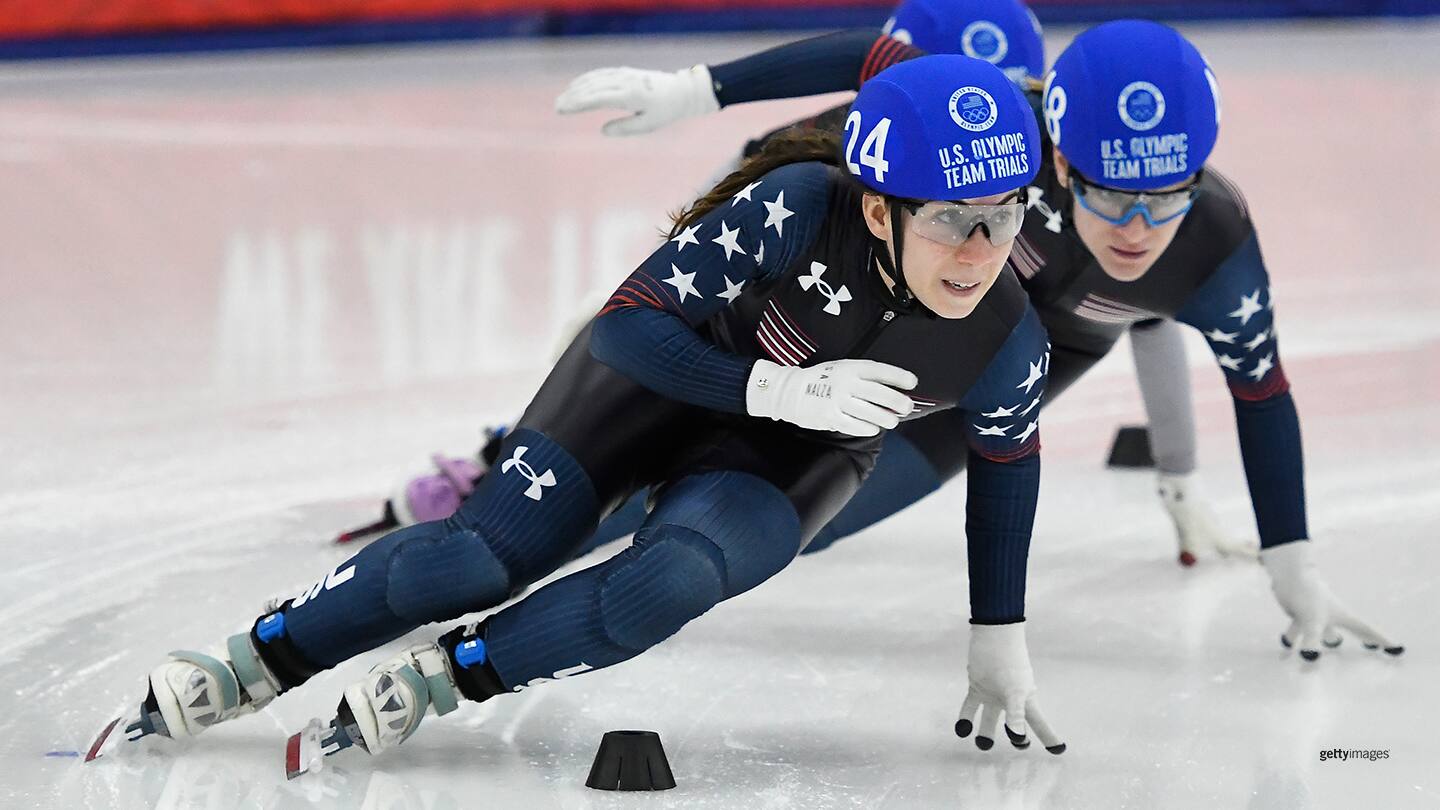
The New Olympic Mixed Team Relay Combines Speed And Strategy On The Short Track
by Steve Drumwright

Julie Letai looks on before the women's 1000-meter final at the U.S. Short Track Speed Skating Olympic Trials on Dec. 18, 2021 in Kearns, Utah.
Speedskating has always been an enthralling Olympic sport. The addition of the short track discipline in 1992 added a fast-paced element where skaters jostle for position in tight spaces and are sometimes knocked off the course in dramatic crashes.
Short track speedskating really grabbed U.S. spectators’ attention in 2002 when the Winter Olympics were held in Salt Lake City. American star Apolo Anton Ohno won the first two of his eight Olympic medals, making him Team USA’s most decorated Winter Olympian by the time he retired in 2010.
With the International Olympic Committee continually creating events with women and men competing together, short track is one of four sports that will include a new mixed team race at the Olympic Winter Games Beijing 2022, bringing the total number of mixed events at the Winter Games to nine.
Julie Letai, a 21-year-old from Medfield, Massachusetts, qualified for her first Olympics in Beijing, where she’s expected to race on the women’s 3,000-meter relay team and is a candidate to be one of the two women on the 2,000-meter mixed relay team.
“I think it’s cool,” Letai said of the mixed team debut. “If anything, just for the variety it's cool, but also the symbolism of it, the genders working together. And I think it kind of insinuates a more equal platform as well and that we can all work together no matter what.
“It doesn’t have to always be women and men (separately), but it’s just about like more of the whole cohesive team in general. So I think it’s a cool movement.”
Similar to the women’s relay, the mixed relay has four competitors on each team. Each gets two legs of the 18-lap race around the track, which is just over 111 meters around. The women take the first two turns, followed by the men. The first leg for each athlete is 2.5 laps, then they go two laps the second time out. With the two genders and the different lap counts, there is plenty to keep track of while also wanting to skate your best.
“When I’m in a relay, I’m just constantly repeating the number of laps over and over in my head to make sure that I’m not forgetting it,” said Letai, the first alternate for the 1,500-meter event. “I would say that’s more the confusing part because it’s the same person that you go out for every time. But making sure that you’re starting to get ready at the right time and counting the right number of laps so you come out at the right time is the harder part.”

Julie Letai competes in the women's 1000-meter semifinal at the U.S. Short Track Speed Skating Olympic Trials on Dec. 18, 2021 in Kearns, Utah.
The mixed team relay first came onto the world cup tour during the 2018-19 season, Letai’s first with the national team. The Olympic debut will take place Feb. 5 at the Capital Indoor Stadium, which will also host the figure skating competition.
In order to win a medal, the U.S. would have to advance from the quarterfinals to the semifinals and then to the medal race. There are 16 countries in the field.
Letai, who had surgery on her right knee in the summer of 2018, and then on the left knee two summers later, said the most challenging aspect of the mixed team relay is getting used to the speed of the men during the handoff.
“The speed can be intimidating,” Letai said. “We’ve practiced it a lot, so by the time it’s race time, (the exchanges are) OK. But I would say we’re at a little bit more risk just because guys obviously tend to accelerate up to a higher speed and then there’s also a lot more mass usually coming for the guys when they’re pushing a female that usually weighs less. So it can be a ton of force that’s coming at the female exchanging and you definitely have to find a way to handle that and then be able to get through that first corner even though you have a ton of speed.”
A big difference between the women’s relay and the mixed relay is the philosophy. At 3,000 meters, the women’s relay is 1,000 meters longer, which means a total of 27 laps.
“It can be a totally different strategy, and it kind of depends on how the race goes out,” Letai said. “But the mixed relay feels a lot more like one and done because you just go out two times and that feels like nothing.
“If you can picture it like a sprint versus a marathon and the strategies that come with that. The women’s relay, there’s more time it feels like to think about and you’re skating more times, there’s more opportunities for you to try to figure out what the best move is in terms of placement for your team and blocking and stuff like that. So there’s just more chances for you to do things and change the way the race is going.”
Steve Drumwright #
Steve Drumwright is a journalist based in Murrieta, California. He is a freelance contributor to TeamUSA.org on behalf of Red Line Editorial, Inc.